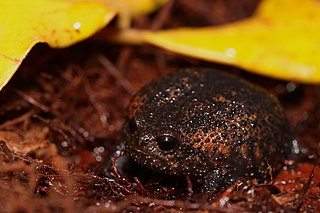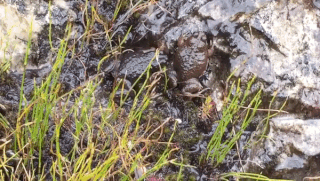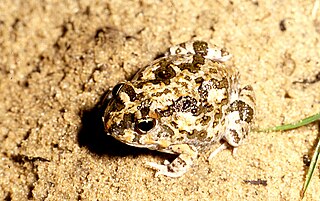
Breviceps is a genus of frogs in the family Brevicipitidae. Species in the genus Breviceps are commonly known as rain frogs or short-headed frogs. They occur in arid to semiarid climates of East Africa and Southern Africa.

Tomopterna is a genus of frogs from sub-Saharan Africa.

The Cape mountain toad or Rose's mountain toad is a species of toad in the family Bufonidae. Other common names include Rose's mountain toadlet, striped mountain toad, Rose's toad, and Muizenberg Cape toad. It is endemic to South Africa, where its natural habitat is Mediterranean-type shrubby vegetation known as fynbos. It is threatened by habitat loss.

Weale's running frog, also known as Weale's frog, rattling frog, and many other commons names, is a species of frog in the family Hyperoliidae. It is monotypic within the genus Semnodactylus. It is found in southern and eastern South Africa, Lesotho, and Eswatini.

Breviceps acutirostris, also known as common rain frog, strawberry rain frog, or Cape short-headed frog, is a species of frog in the family Brevicipitidae. It is endemic to the southwestern Cape region in South Africa. It is a burrowing frog that lives in fynbos heatland and forests at elevations below 1,600 m (5,200 ft) above sea level. Development is direct . It is threatened by habitat loss, although much of its habitat is also protected.

Breviceps adspersus, also known as common rain frog, bushveld rain frog, and many other vernacular names, is a species of frog in the family Brevicipitidae. It is found in Southern Africa, in Angola, Democratic Republic of the Congo, Namibia, Botswana, Zambia, Zimbabwe, South Africa, Eswatini, and Mozambique.

Breviceps fichus is a species of frog in the family Brevicipitidae. It is endemic to the central highlands of Tanzania. Common name highland rain frog has been proposed for it.

Breviceps fuscus, also known as black rain frog, plain rain frog, brown short-headed frog, and Tsitsikama rainfrog, is a species of frogs in the family Brevicipitidae. It is endemic to the southern coast of South Africa.

The cape rain frog or giant rain frog is a species of frog in the family Brevicipitidae. Adults grow up to 45 mm in length. It was the first African frog species to be scientifically described by Carl Linnaeus in 1758, under the name Rana gibbosa. It is the most common and largest of rain frogs. The name "rain frog" that is applied to the genus refers to a belief that these frogs bring rain.

The desert rain frog, web-footed rain frog, or Boulenger's short-headed frog is a species of frog in the family Brevicipitidae. It is found in Namibia and South Africa. Its natural habitat is the narrow strip of sandy shores between the sea and the sand dunes. It is threatened by habitat loss by such factors as mining and tourism.

The Mozambique rain frog, also known as the flat-faced frog, is a species of frog in the family Brevicipitidae. It is found in Botswana, Democratic Republic of the Congo, Eswatini, Malawi, Mozambique, South Africa, Tanzania, Zambia, Zimbabwe, and possibly Lesotho. Its natural habitats are dry savanna, moist savanna, temperate shrubland, subtropical or tropical dry shrubland, temperate grassland, subtropical or tropical dry lowland grassland, subtropical or tropical high-altitude grassland, arable land, pasture land and rural gardens.

The Namaqua rain frog or Namaqua short-headed frog is a species of frogs in the family Brevicipitidae. It is found in Namaqualand in western South Africa and extreme southern Namibia.

Breviceps poweri, the Power's rain frog or Power's short-headed frog, is a species of frog in the family Brevicipitidae. It is found in northeastern Angola east through Zambia, southern Democratic Republic of the Congo, and Malawi, to western Mozambique and northeastern Zimbabwe; possibly in Namibia. The specific name poweri honours John Hyacinth Power, Irish-born director of the McGregor Museum who collected amphibians as well as reptiles and plants.
The whistling rain frog is a species of frogs in the family Brevicipitidae. It is found in South Africa, Eswatini, and possibly Mozambique. Its natural habitats are temperate forests, dry savanna, moist savanna, and sandy shores. It is threatened by habitat loss.

The plaintive rain frog or rough rain frog is a species of frog in the family Brevicipitidae. It is found in Lesotho, South Africa, and Eswatini. Its natural habitats are temperate forests, dry savanna, temperate shrubland, temperate grassland, and rural gardens. It is threatened by habitat loss.

The micro frog, or Cape Flats frog, is a species of frog less than 2 cm (0.8 in) long in the family Pyxicephalidae, in the monotypic genus Microbatrachella. Its color varies from rufous brown with dark mottling, to tan or green, depending on the population. It is endemic to the south-western Cape area of South Africa, with a single population found on the Cape Flats of Cape Town and several populations on the eastern side of False Bay. It typically lives in wetlands in coastal fynbos habitats, but its total area of occupancy is very small, and the International Union for Conservation of Nature has rated it as being "critically endangered".

Poyntonia, is a monotypic frog genus in the family Pyxicephalidae. It was named after J.C. Poynton, a notable herpetologist who worked in southern Africa.

Delalande's sand frog, also known as Delalande's frog, Cape sand frog, or striped pixie, is a species of frog in the family Pyxicephalidae. It is endemic to western and southern South Africa and occurs in the low-lying areas of Namaqualand, Western Cape, and Eastern Cape as far east as Cape St. Francis.

The knocking sand frog, also known as sandveld pyxie or Kruger burrowing frog, is a species of frog in the family Pyxicephalidae. It is found in southern Angola, Namibia, Botswana, southern Zimbabwe, southern Mozambique, northern South Africa, and Eswatini. This species was discovered during the evening of 23 October 1973 in South Africa's Kruger National Park. Two weeks after heavy rain fell in the area, large numbers were found around the Machayi and Mathlakuza Pans in the northeastern part of the Park near the Mozambican frontier.




















